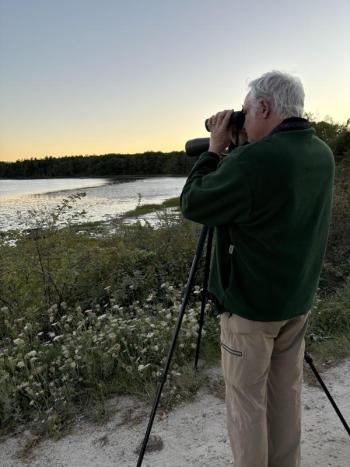It’s a cool, early-September evening on the Maine coast. On the point across the water from where we’re standing, tall white pine trees create a light green curtain against the impossibly blue sky. Behind us, water flows from a small salt marsh as the tide begins to recede. An all-white great egret, with its black legs and bright yellow bill, dances along the muddy edge. Its larger cousin, the great blue heron, stands on a barnacle-encrusted rock, its necked tucked into its body, looking contemplative.
We are standing on a dirt road near a wooden bridge at the Wolfe’s Neck Center in Freeport, Maine. A last-minute whim brought us here on a Sunday evening. There are lots of other people here, too, walking dogs, pushing strollers, taking photos.
The lowering tide is exposing more tidal flats on the bay side, and the distinctive smell of mud and salt is wafting through the crisp air, mixed with a hint of rotten egg. Some people don’t like the smell. Having grown up along the Maine coast, it is a smell that brings back years of memories for us.
We notice below us that the expanding muddy shore seems to be moving. Small, inconspicuous shorebirds are busying over the glistening brown muck, picking rapidly at things we can’t see. Most of them are brownish-gray-backed semipalmated sandpipers. with their black legs and black bills. Most of the ones we can see have the crisp, fresh, light-fringed back feathers of juveniles—birds hatched just a few months ago. They are on their first journey south from the Arctic or sub-Arctic of Canada or Alaska. The closest they could have hatched is in Hudson-James Bay, at least 800 miles away. But they may have come from two or three times that distance.
Suddenly, the little sandpipers take off in a compact group out over the water. Out of the corner of our eye we see why. A Cooper’s hawk glides low over the road and drops down the bank toward the mudflats. The shorebirds react so quickly that the hawk doesn’t stand the slightest chance of catching one. It diverts back inland into the low bushes.
But the disturbance has caused more shorebirds scattered up the shore to take flight. We hadn’t realized how many were there—a swirling, swiftly shape-changing flock of at least 300 birds is now flashing low over the water. After a minute or so, the entire flock swoops in and lands right below us!
Among the sandpipers are a few slightly larger semipalmated plovers. We hear their mellow “pu-wee” calls rising up from the shore and imagine how all these birds may have been up in the land of polar bears just days ago.
And in a few days or weeks they may be passing over Caribbean islands and landing on the shores of a steaming mangrove wetland on the coast of South America. Already, birders in places like Barranquilla on the Caribbean coast of South America have spotted flocks of returning semipalmated sandpipers.
Now, today, on this early September day on the coast of Maine, we are reveling in the experience of standing only feet away from these little birds that somehow migrate across the hemisphere, season after season. We watch, we listen, and we feel somehow connected into something bigger than ourselves.
Jeffrey V. Wells, Ph.D., is a Fellow of the Cornell Lab of Ornithology and Vice President of Boreal Conservation for National Audubon. Dr. Wells is one of the nation's leading bird experts and conservation biologists. He is a coauthor of the seminal “Birds of Maine” book and author of the “Birder’s Conservation Handbook.” His grandfather, the late John Chase, was a columnist for the Boothbay Register for many years. Allison Childs Wells, formerly of the Cornell Lab of Ornithology, is a senior director at the Natural Resources Council of Maine, a nonprofit membership organization working statewide to protect the nature of Maine. Both are widely published natural history writers and are the authors of the popular books, “Maine’s Favorite Birds” (Tilbury House) and “Birds of Aruba, Bonaire, and Curaçao: A Site and Field Guide,” (Cornell University Press).


.jpg)






























.png)

.png)
